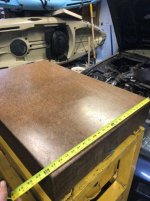jmoore2784
Plastic
- Joined
- Nov 4, 2019
Hey guys,
I posted this in General but was told that it may get more response here.
Picked this guy up today for a steal. It has some imperfections and needs to be lapped and I will build a proper stand for it in the coming days (suggestions on a propper stand would be appreciated). Anyone have any recommendations on where to get a lapping fixture for this size plate (24x36) or who have any experience with a resurfacing company in the Ohio valley, Kentucky, Tennessee area. I looked up Precision Granite in Tennessee and the have some decent testimonials. What am I looking at price wise to get this thing into A grade or even AA grade shape. Anyone have any data on the Velsey Company, I cant find anything about them on that standard search engines.
It is going to be used in a hobby shop but I have an avenue to check/calibrate reference surfaces in the near future so that is why I am thinking about AA.



 Thanks
Thanks
I posted this in General but was told that it may get more response here.
Picked this guy up today for a steal. It has some imperfections and needs to be lapped and I will build a proper stand for it in the coming days (suggestions on a propper stand would be appreciated). Anyone have any recommendations on where to get a lapping fixture for this size plate (24x36) or who have any experience with a resurfacing company in the Ohio valley, Kentucky, Tennessee area. I looked up Precision Granite in Tennessee and the have some decent testimonials. What am I looking at price wise to get this thing into A grade or even AA grade shape. Anyone have any data on the Velsey Company, I cant find anything about them on that standard search engines.
It is going to be used in a hobby shop but I have an avenue to check/calibrate reference surfaces in the near future so that is why I am thinking about AA.



 Thanks
Thanks

